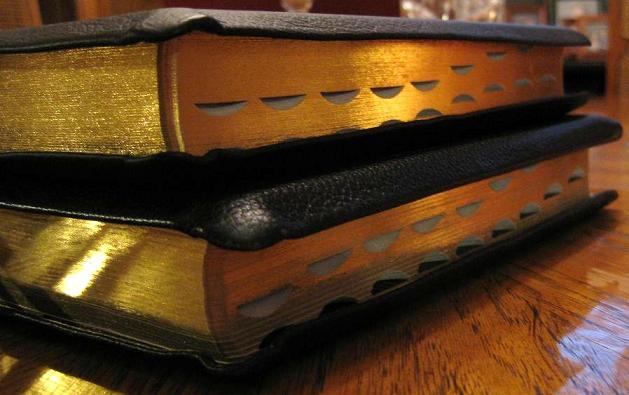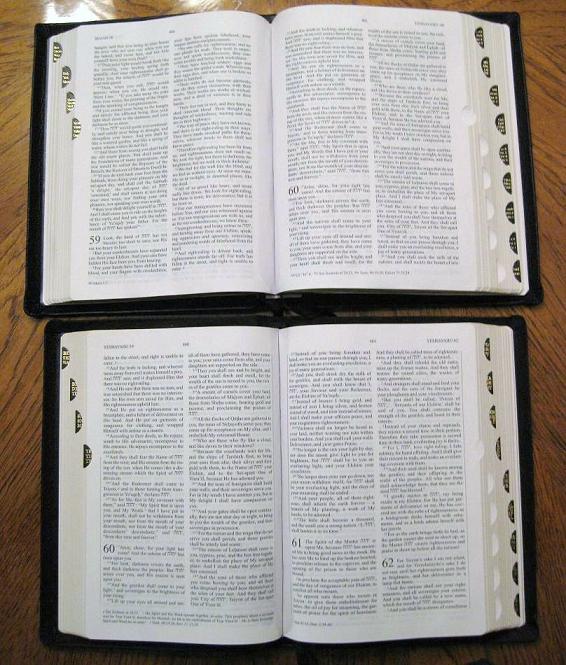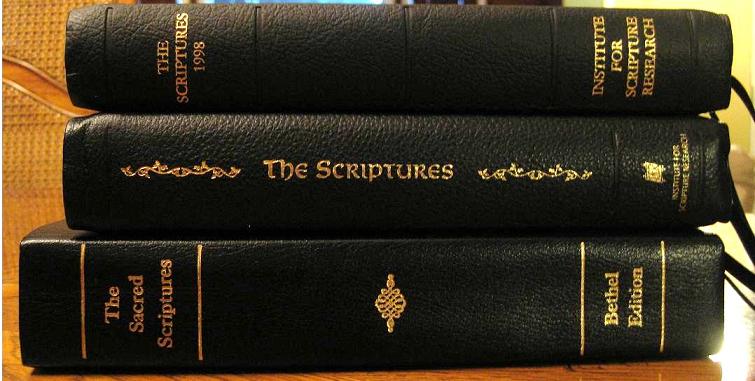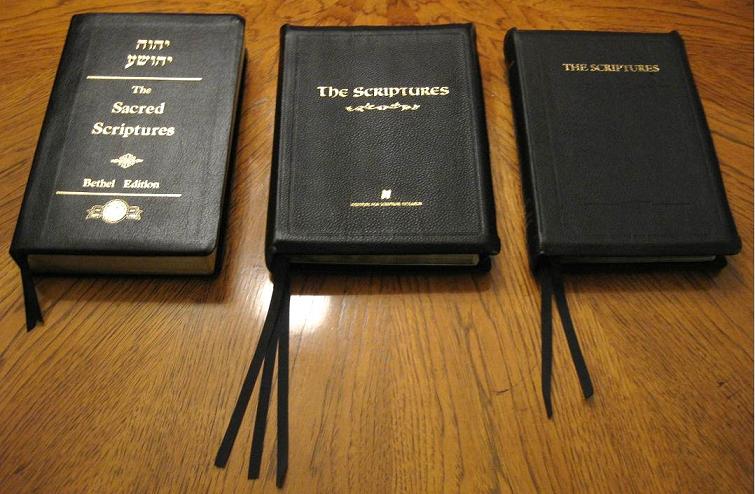Rating
Price and Value
Scroll down to the bottom for pictures!
Summary of Features
Feature
Publication Date
1st Edition: 1993
2nd Edition: 1998
3rd Edition: 2009
Cover
Genuine Leather w/Partial Yapp
Size
8.15 inches tall
6.06 inches long
1.75 inches thick
Binding
Smyth-Sewn with reinforced binding
Thumb-Index Tabs
Yes
Text Format
Verse Format
Headings
None
Mashiyach's Words in Red
No
Number of Ribbon Markers
Three
Gold Gilded w/ Rounded Corners
Yes
Extensive Cross References
No
Helps
11 Pages of Explanatory Notes
Weights and Measures
Illustrations
Flood and Patriarch Timelines
Footnotes
Basic Cross References
Minimal Alternative Manuscript Readings
Concordance
No
Maps
Yes
Name of the Father
יַהְוֶה
Name of the Son
יֵשׁוּעַ
Hebrew Transliterations
All Names, Some Titles
Book Order
Hebrew Order
Torah
Prophets
Writings
Western Greek Order
Gospels/Acts
Pauline Epistles
General Epistles
Revelation
Base Text
None
Old Archaic English
No
Manuscript Origin
Hebrew Masoretic Text (primary)
Greek Byzantine Text (primary)
Greek Critical Text (consulted)
Shem Tob Hebrew Matthew (consulted)
Review
This is probably the nicest version of a "Sacred Name Bible" available. The 2009 leather edition far surpasses the quality of both the leather edition of "The Word of Yahweh" and the leather edition of "Sacred Scriptures Bethel Edition". The translation itself I give about 3.5/5 stars (I will cover why below) but the leather edition is so nice for these types of Scripture versions that I'm giving this review 4 our of 5 stars.
First, although not specified, I can tell that the leather is genuine (not bonded), thicker than the second edition, and it feels nice and soft. When I first got it, the cover was somewhat stiff, but not because the leather was not soft, rather, it was because the inside cover that it was attached to was stiff, just like in the second edition. This meant it didn't have a pronounced "drooping" effect, but it started to soften up even after just a week and now it droops fine :) The stiffness is from a couple things. First, the inner cover / lining page is not leather (like most other bindings... only top of the line Cambridge and R.L. Allan versions have leather on the inside too). Second, the glue on the back of the inner lining page that connects to the cover seems to be the real culprit. This does become more and more flexible with time, but the cover can seem somewhat distorted depending on how you end up bending it. It's definitely the nicest cover out of any "Sacred Name Bible" though, and better than any imitation leather / leatherette by far. Even before it had softened up, I remember that there were no problems with these Scriptures opening up flat and it has always felt fantastic in the hands. The leather folds over the edge like many R.L. Allan Bible's (called a "yapp") and looks quite nice while offering some extra protection for the pages at the same time. It comes with THREE very long ribbon markers, an improvement over the two that came with the second edition, and these are great for marking the Torah, Haftarah and Ketuvim Netzarim readings for the week. The ends of the ribbon markers are also singed to avoid any fraying which is a big bonus. The Scriptures are thumb indexed with the Hebrew transliterated abbreviations on the tabs which I've found is very helpful in memorizing the book names in Hebrew (this is important since they use these abbreviations in the footnotes, which is fine for the Tanak, but for the NT books this can be annoying if you haven't got the Hebrew forms of those books memorized). The gold gilded edges, rounded corners, and gold lettering on the front are all very nice. The paper is the same as the paper from the second edition, the margins are just wider so the paper size is bigger. It's the exact same paper as the hardcover version, just with the gilded edges and rounded corners. The binding is still the best I've seen on any Sacred Name Bible, but I dislike how sometimes when there are a lot of pages together, the pages get stuck and will stick straight up when you open it a certain way or flip a large chunk in the center with your hand. The second edition never did this and it's a big draw back in my opinion. There's a certain stiffness to the paper/binding that makes it do this (i.e. this is not "india bible paper" with a perfectly sewn binding). See the pictures below to see what I mean. Finally, the binding, while smyth-sewn, is still done with the "improved reinforced binding" of the second edition. This results in a fair bit of noise as you turn the pages, and it seems a bit worse since the 2005 print.
Now for the translation. The Scriptures by the Institute for Scripture Research out of South Africa is a Messianic Sacred Name translation, now in it's 3rd edition (2009; 1st edition published 1993, 2nd 1998). Updates to the 3rd edition include some improvements to the text itself; the removal of doctrinal comments from the footnotes and marginal lines indicated unfulfilled prophecies (most of which I enjoyed); Tanak quotes in the Nazarene Writings are now in bold; and finally, there are some added illustrations and color maps on glossy paper at the back.
Unlike many of the Sacred Name versions of the Scriptures out there, this one was done by more than just one individual, even though C.J. Koster was the main person in the initial 1st edition printing (Dr.Koster passed away in 1996 though). The intentions of the translators is very well described in the preface to the text which can be read for free on their website. As far as I'm concerned, their intentions are very sincere, worthy and needed.
This is an extremely literal translation! They wanted to stay as true and accurate to the original text as possible, and in doing so offer one of the most precise word for word translations I've ever seen! Unfortunately, this makes for some rough reading at times. If you're not careful, you will miss the point of the passage in some places (mostly in places like Samuel and Kings). But then again, Scripture reading isn't meant to be just casual. We should be diligently paying attention, not falling asleep before bed trying to get our reading done, and the accuracy coming from the literal translation style is fantastic (very little bias is found with this style, unlike paraphrased thought for thought versions which I do not personally recommend what so ever). This version of the Scriptures forces you to pay attention, which is great and has helped me study quite a bit. To get a feel for the text though, you can read the 1998 version for free at Eliyah's page (just do a quick web search) and also on e-sword, or you can see samples of the 2009 version on the ISR website.
The very best thing about this particular translations of the Scriptures is the insertion (or should I say, restoration!) of the name of YHWH and Y'shua with Hebrew characters (technically, the characters read Yehoshua instead of Y'shua, but that shouldn't be an issue for most readers I don't think). By using the Hebrew characters, one can pronounce the name however they wish. No other version of the Scriptures at this moment has done this (with the exception of "the Besorah", which is a plagiarized version of this translation that used Paleo-Hebrew for the name instead, and a few cheap versions on lulu). The second best thing about this translation is that they are very careful at avoiding any names or titles of pagan origin (with the exception of the names that are describing or pointing to an actual pagan deity of course, such as Ba'al). This means you will see Master instead of lord, Elohim or El instead of God, mighty one instead of god, Sovereign instead of king, Set-Apart instead of holy, etc. It's almost excessive in some cases, but the efforts are very honorable and it's great for those who strive to follow the commandment of Exodus 23:13 and/or want to have more accurate renderings of some words. The other goal of this translation was to use Hebrew transliterations as opposed to translations, and as such, you will see every name and place written with it's Hebrew pronunciation (Moshe instead of Moses, Eliyahu instead of Elijah, Mitsryaim instead of Egypt, etc.) This can be difficult for those not familiar with these names or who prefer more English renditions of names and places. But in terms of offering a translation which transliterates the names and places, The Scriptures by ISR does this flawlessly (and once you're used to Hebrew transliterations, you begin to miss them when going back to other versions).
Outside of the above highlights however, problems with the translation do exist. As mentioned, the literal approach of the translation makes the reading quite rough sometimes (the NASB, also a literal translation, is generally smoother). This can be due to the transliteration of Hebrew names (it can get a bit intense when reading Samuel/Kings if you're not used to it), but is also sometimes because of poor wording in general. There are certainly better choices for some of the words they used in translating. For example, faith is usually rendered as "belief" in the Messianic Scriptures, and they have an explanatory note for this in the back, but faith is still a better choice for the translation. Renewed is also put in a few places where it should simply be "new" (even if there are some twisted ways in which you can justify it). Impale is unfortunately used instead of crucify. Messiah was not impaled, he was nailed to a stake, so a better choice would have been "execute". The Tanak translation is excellent though and the only real issue I've had is with a translation error in Habakkuk 1:12 (it says You shall not die, referring to Elohim, when it should say "we shall not die). But overall I must say that is IS a very good translation, and I use it more then any other Messianic or Sacred Name translation (with the exception of Andrew Gabriel Roth's AENT). The Tanak is based off the Masoretic text and I haven't noticed any variation from it. The Messianic Scriptures are based on the Textus Receptus (Received Text, also known as "Majority Text") with a few small changes in light of readings from earlier Greek manuscripts (Sinaiticus, Vaticanus, Alexandrius codexes, together making up the "Critical Text"). There was no consideration given to the Aramaic manuscripts, though Matthew references some (but not all) of the variations in the Hebrew manuscripts which were written at a later date (mostly the Shem Tov text).
Now, some readers won't be familiar with the style that they use in translation, but the sentence structure is sometimes very similar to the KJV (without the old English) so if you're used to reading that it shouldn't be too bad at all. The ISR is set up in a verse by verse format which, although great for quick reference, can disrupt the flow of reading and doesn't help with putting things into context like paragraph form does. It should also be noted that there are no sub-headings for anything either, as the translators feel that this would be adding to the text. But while I am voicing some complaints, I must also stress once again that this forces you to pay attention in your studying which is fantastic. Scripture reading shouldn't be a brisk, casual task.
The Tanak book order is in the traditional Hebrew book order: Torah, Prophets, and Writings. The only difference is that Daniel is included with the Prophets instead of the Writings. The Ketuvim Netzarim (new testament) is in the traditional western Christianity book order that we commonly see today. The ISR aims to restore the name of YHWH into the New Testament text as many Sacred Name Scriptures do, and while they are much more accurate (and conservative) then many other versions (such as Sacred Scriptures: Bethel Edition or The Word of Yahweh) they still insert the name in a few places where it shouldn't be, and miss putting it where it should be. What's my basis for stating that? Well, the original Aramaic manuscripts of the New Testament DO in fact include the name of YHWH in it's Aramaic equivalence (MarYah) which adds a substantial amount of clarity to the text (something every Greek translation will miss). But this proven evidence is not followed by the ISR for probably much the same reason as other translators who know this (the controversial implications that some passages state in terms of Y'shua's identity). Andrew Gabriel Roth's Aramaic English New Testament (the AENT) is a substantially more accurate translation that is faithful to the original Aramaic text with YHWH's name, so I recommend that for the "New Testament". The ISR's Tanak though is very good if you don't mind the literal approach they take, the Hebrew names, and the sometimes funny wording. I've used it for the majority of my Tanak readings because of their efforts to rid the text of all pagan insertions, and it's been absolutely fantastic for that. I also reference the New Testament whenever I'm in a Shabbat service, but I almost always use the AENT for my personal reading and as part of my in-depth studies. This translation is good for a change once in awhile though.
At the back, there is a section of explanatory notes that are references in their foot notes throughout the text. These are short and can be useful in your studies as a reference to compare to other materials. Overall, this is a decent translation and the literalness is fantastic (once you get into thought for thought or paraphrasing, you're putting a lot of trust in the translators bias and opinions). But like I said, it is by no means an easy read, so I wouldn't recommend it as being a primary translation to anyone (not for in-depth studying, anyway), but it is certainly a fantastic addition to your library. If I could make any changes, I would clean up the text/translation a bit; use the Aramaic as the source text for the NT (inserting the name of YHWH in all the correct spots); change the NT book order to the Eastern canon with Paul's letters last (but before Revelations); put in paragraph formatting, headings, and more extensive cross references in the center; and like most westerners, I prefer Mashiyach's words in red. I would also put YHWH's name into Paleo Hebrew in the Tanak. Ever since I saw that the Dead Sea Scroll Scribes kept the name in Paleo-Hebrew despite the change of script, I've preferred that. I would keep it in modern Hebrew in the NT though. These details reflect my perfectionist personality though, so let me finish this review by stating that this is the nicest and most accurate complete Sacred Name Bible ever produced as of this date (I say complete because I again highly recommend Andrew Gabriel Roth's Aramaic English New Testament as a Ketuvim Netzarim gold standard). May YHWH bless you in your studies of the Scriptures.Pictures
Click on an image for a bigger picture
Gold lettering on the front and a nice genuine leather texture. If you notice any creases, these are from trying to make the cover a little more flexible. The page connected to the leather just inside the cover also has a few bends at the top. It still holds together fine, but they really should have used a more flexible page.
As you can see, the book is fairly thin compared to the other Sacred Name Bibles reviewed here. The first half of the thumb index tabs face in the opposite direction so that when you open the book in the middle you can see both sides. Notice also the partial yapp where the leather folds over the pages slightly. Not only does this give a different look, but it also helps protect the pages slightly.

Here it is compared to the 1998 edition. Notice that the leather is thicker and of a different texture on the 2009 edition (shown on the bottom). The gilding is also done slightly differently.
Beautiful gold lettering on the spine as well. Notice how the leather is rounded on the corners of the spine and not a sharp corner. From the yapp you can also see pinched corners on the egde.
At Genesis 1 there is absolutely no problem with the book opening up flat. Notice the standard verse format.

Here it is flat. Notice the leather yap gives it a bit of a nice border. You can see how the index tabs face from this direction. Notice also that there is no real bleed through.

Here it is flat compared to the second edition. Notice that the margins are wider, the pagination is slightly different, and there has been a removal of doctrinal footnotes and unfulfilled prophecy lines.
The gold gilded edges are surprisingly not as nice as I thought they would be. The three ribbon markers are very helpful though. Notice with the binding that there is no extra space in the spine when opening up flat.

Here is the gold gilding compared to the previous edition. It was actually a little bit smoother on my 1998 edition. Notice also how the 2009 edition is wider.
No problems with flexibility once it softened up. Here you can see the full length of the ribbon markers. When I first got this version I thought about shortening them, but decided to leave it. They can always be tucked in the back or front cover if needed.
Held in the hand, more than any other Sacred Name Bible, this one droops the best and feels the nicest due to the genuine leather.
Here's that strange stiffness I was talking about in the review when you try and flip a lot of pages at once. This is due to the reinforced binding they use, but it didn't happen much on the second edition (probably due to the smaller page size).

The nicest spine and an average thickness.

In terms of size, I would say that The Scriptures is better than the Sacred Scriptures: Bethel Edition, but it's a bit wider than the 1998 edition which some may or may not prefer. However, I do feel that it's perfect for both carrying around and holding while having a text size and font that is very readable. Notice the length of the ribbon markers on the third edition compared to the second edition.
~~~~~~~~~~~~~~
RETURN TO HOME PAGE